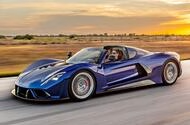Ever find yourself daydreaming about the world’s fastest cars and the engineering marvels behind them? If so, you’re not alone. The Hennessey Venom F5, with its audacious aim of hitting speeds over 310 mph, is a prime example of how design and physics intertwine in the pursuit of automotive excellence. But what does it really take to push the boundaries of speed? Let’s dive into the fascinating world of hypercar design and the challenges that come with it.
Why Do Supercars Aim for 217 mph?
You might have noticed that many supercars boast a top speed of “217 mph-plus.” This isn’t just a catchy marketing line; it’s a strategic choice. The McLaren P1, LaFerrari, and Lamborghini Revuelto are just a few that flirt with this figure. Why this specific speed? It’s a clean conversion to just under 350 kph, making it a sweet spot for manufacturers. But there’s more to it than just numbers.
Nathan Malinick, the director of design at Hennessey, points out that once you cross the 220 mph threshold, the challenges multiply exponentially. “Most hypercars can do that no problem,” he explains, “but 250 mph and above remains very, very difficult.” It’s not just about raw power; it’s about mastering aerodynamics and engineering.
The Aerodynamics of Speed
When it comes to the Venom F5, the stakes are incredibly high. With a theoretical top speed of over 310 mph, the design team faces unique aerodynamic challenges. Malinick, who has a background in aerospace, emphasizes the importance of efficiency. “If our target was closer to 200 mph, the requirements would be totally different,” he notes. At these extreme speeds, the car is not just a vehicle; it’s a finely tuned machine that must navigate the complexities of airflow and drag.
One of the standout features of the Venom F5 is its lack of active aerodynamics. While many supercars rely on adjustable elements to optimize performance, Hennessey opted for a design that minimizes potential failure points at high speeds. “You’re not going to see the flicks and blades of an F1 car on an F-35 or F-22 jet,” Malinick says. This decision reflects a commitment to top speed without compromising safety or reliability.
Balancing Beauty and Functionality
In the world of supercars, aesthetics play a crucial role. After all, these machines are often seen as status symbols, and their design needs to resonate with collectors who already have a garage full of luxury vehicles. Malinick acknowledges this challenge, stating, “Our design and engineering teams work hand in hand.” This collaborative approach ensures that beauty doesn’t come at the expense of performance.
The design process is dynamic, with real-time feedback between engineers and designers. If a design element doesn’t meet aerodynamic standards, it can be quickly adjusted. This iterative process allows for a seamless blend of form and function, resulting in a car that’s not only stunning but also capable of achieving its ambitious speed goals.
The Creative Process Behind the Venom F5
Despite the high-tech nature of hypercar design, Malinick still relies on traditional methods—like sketching—to bring his ideas to life. “I do a ton of sketching,” he admits, revealing that he has thousands of sketches for the F5 and future projects. This hands-on approach keeps the creative spirit alive, allowing for innovation that’s rooted in artistic vision.
So, what’s next for Hennessey? While the Venom F5 focuses on performance, the next model aims to enhance the driving experience itself. “If the F5 is all about performance, the next car is about driving interaction,” Malinick shares. This shift suggests a move towards a more analog experience, perhaps even steering away from turbocharging to embrace high-revving engines that deliver pure driving pleasure.
The Future of Hypercars
As we look ahead, it’s clear that the world of hypercars is evolving. The blend of cutting-edge technology and a return to simpler, more engaging driving experiences could redefine what we expect from these machines. Whether it’s through innovative aerodynamics or a focus on driver interaction, the future promises to be as thrilling as the cars themselves.
The big takeaway? Pushing the limits of speed isn’t just about raw horsepower—it’s about smarter design choices and a deep understanding of physics. As we continue to witness the evolution of hypercars, one thing is certain: the journey is just as exciting as the destination. So, keep your eyes peeled for what’s next in this fast-paced world, and who knows? You might just find yourself inspired to make a change in your own life, whether it’s behind the wheel or beyond.

